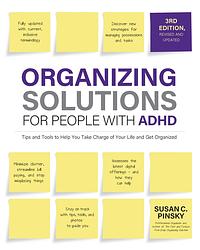Take a photo of a barcode or cover
informative
inspiring
medium-paced
Good practical solutions for making things easy to put away and manage at home.
I read the new 2023 edition and I think what I liked best about the book is that it acknowledges that the organizational systems that get the job done and require minimal effort may look inelegant, and that's ok.
As other reviewers pointed out, sometimes the book feels geared to parents and partners of people with ADHD, rather than speaking directly to people with ADHD. Still, I would give it 3.5 stars because I think the overall philosophy of striving for minimalism and efficiency has helped me achieve a (somewhat) less chaotic apartment, and there were some helpful ideas that I would like to try. I don't think the suggested solutions will be universally helpful (I think that would be impossible as noone's ADHD experience is the same), and I can't really speak to how helpful this book would be for someone who is feeling completely overwhelmed by home organization. But I think it might at least offer some practical ideas as well as insight on why things DON'T work.
As other reviewers pointed out, sometimes the book feels geared to parents and partners of people with ADHD, rather than speaking directly to people with ADHD. Still, I would give it 3.5 stars because I think the overall philosophy of striving for minimalism and efficiency has helped me achieve a (somewhat) less chaotic apartment, and there were some helpful ideas that I would like to try. I don't think the suggested solutions will be universally helpful (I think that would be impossible as noone's ADHD experience is the same), and I can't really speak to how helpful this book would be for someone who is feeling completely overwhelmed by home organization. But I think it might at least offer some practical ideas as well as insight on why things DON'T work.
This is a good book overall. Some ideas are great (give each family member his/her own color of towels and his/her own laundry day, hang a long wire rack on the bathroom door, store magazines vertically in baskets and racks, put recycling bins all over the house). Some suggestions are silly--e.g. don't itemize donations because it's an inefficient use of time (I spend about 10 minutes each year on this for hundreds in tax deductions!). And some are just obnoxious (limit photos to 2 per birthday party, 6 per vacation, and 10 per year; save only two pieces of each child's art or writing per year; stop giving friends Christmas presents).
I'm not sure why this is marketed to people with ADHD. The organization tips are potentially useful to anyone.
I'm not sure why this is marketed to people with ADHD. The organization tips are potentially useful to anyone.
informative
medium-paced
While geared toward households in which at least one person has ADHD, the tools and techniques outlined here will be useful to anyone interested in making organization as simple and easy as possible. Pinsky offers no-nonsense advice and realistic solutions for getting rid of clutter (what she calls "the brutal purge") and, importantly, for minimizing the the number of actions and decisions it takes put things back in their proper place. Importantly, the author is painfully clear that organized isn't always pretty: a neat and orderly home will likely not look at all like the ones pictured in magazines and shared via Pinterest and Instagram. No, open topped trash bins are not the most attractive things in the world, but having several of them strategically placed around your home will make your home neater. Her simple filing system--just throw everything in one box, and toss --has been my solution for years, and it works incredibly well. And her minimizing advice is completely on point: Really, you don't need that many photographs, books, etc, no matter how much you love them all.
Obviously, this is useful advice for people who struggle with ADHD or executive functioning challenges. But I highly, highly recommend this book for anyone who suffers from decision overload or who just wants a simpler way to stay organized and minimize/deal with the endless volume of information, paper, and STUFF making demands on our through our attention every single day.
Obviously, this is useful advice for people who struggle with ADHD or executive functioning challenges. But I highly, highly recommend this book for anyone who suffers from decision overload or who just wants a simpler way to stay organized and minimize/deal with the endless volume of information, paper, and STUFF making demands on our through our attention every single day.
There’s lots of good advice in Pinsky’s book, but some of it is quite outdated. I took a “take what resonates and leave the rest” approach, so I’m still glad I read it. Pinsky herself does not have ADHD (her daughter does), and some readers may find this relevant.
It was helpful to learn about ways to simplify systems and remove unnecessary steps. Pinsky also gives her readers permission to sacrifice style for function, a helpful approach for those of us suffering from perfectionism. I found her ideas on organizing bedrooms, office spaces, and bathrooms mostly applicable despite some almost comically biased sections (your teenaged girl will need an area for her hair products, your boy one for his video games!).
However, it was frustrating to read solutions that are largely geared toward people who own entire houses complete with basements (for storage) and dining rooms (which you can repurpose for fun projects!). I kept in mind her basic tenet that your inventory must always be far less than your storage capacity; this is just a lot harder for those of us (most of us?) living in smaller spaces.
It’s well worth a quick read, and you’ll almost definitely want to follow up with (or start with) K.C. Davis’s “How To Keep House While Drowning.”
It was helpful to learn about ways to simplify systems and remove unnecessary steps. Pinsky also gives her readers permission to sacrifice style for function, a helpful approach for those of us suffering from perfectionism. I found her ideas on organizing bedrooms, office spaces, and bathrooms mostly applicable despite some almost comically biased sections (your teenaged girl will need an area for her hair products, your boy one for his video games!).
However, it was frustrating to read solutions that are largely geared toward people who own entire houses complete with basements (for storage) and dining rooms (which you can repurpose for fun projects!). I kept in mind her basic tenet that your inventory must always be far less than your storage capacity; this is just a lot harder for those of us (most of us?) living in smaller spaces.
It’s well worth a quick read, and you’ll almost definitely want to follow up with (or start with) K.C. Davis’s “How To Keep House While Drowning.”
This book was so incredibly helpful in not only understanding how to best declutter and how to organize household chores, but also in helping me better understand myself and how my brain works.
Similarly to The Life-Changing Magic of Tidying Up, this author is a bit extreme on how much of your stuff she thinks you should get rid of. However she has pretty good reasons having to do with ADHD, and I think her logic applies to most people. The unique focus on making things easy to put away is something I haven't seen before and worth contemplating. A very interesting read.



